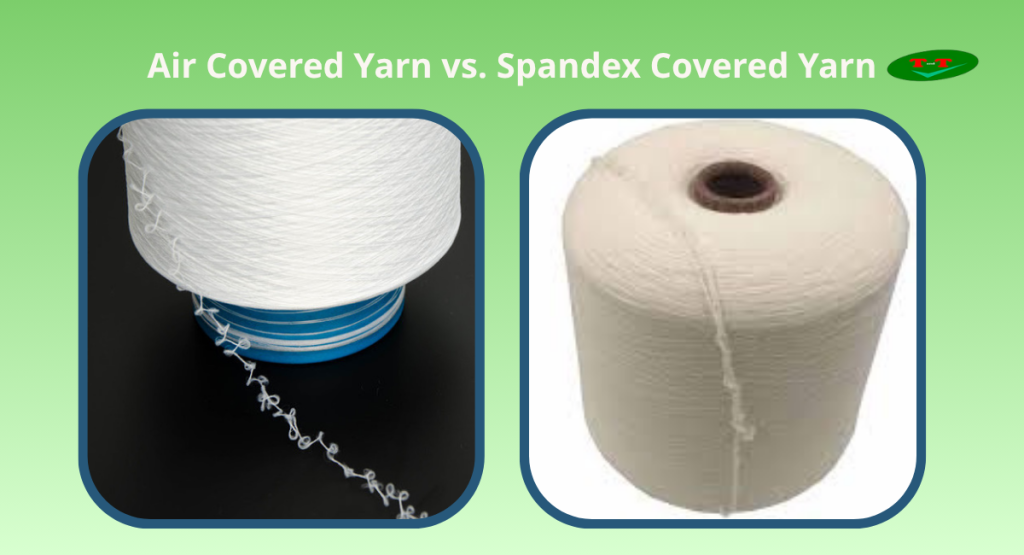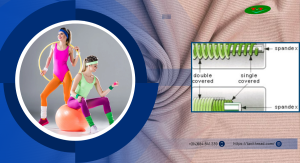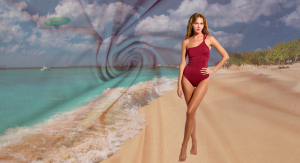In the textile industry, covered yarns are essential for producing stretchable fabrics for fashion and sportswear. Air Covered Yarn (ACY) and Spandex Covered Yarn (SCY) are two of the most common types, each offering distinct performance and hand feel. While both integrate spandex (elastane) with a hard yarn like nylon or polyester, their manufacturing processes result in vastly different characteristics, costs, and optimal applications. Understanding this distinction is crucial for brands and designers to optimize their collections for comfort, durability, and market success.

So, how do you decide which yarn is the right choice for your next project? This article will provide a detailed, head-to-head comparison of Air Covered Yarn and Spandex Covered Yarn, breaking down their production methods, key properties, and ideal use cases. By the end, you will have a clear framework for selecting the perfect yarn to bring your design vision to life.
What is Air Covered Yarn and Spandex Covered Yarn?
- Air Covered Yarn (ACY): In this process, the outer filament and the spandex core are fed together through a specialized nozzle where high-pressure compressed air intermingles them, creating a yarn with periodic network points. The result is a softer, bulkier, and more porous yarn that closely resembles spun yarn.
- Spandex Covered Yarn (SCY – Mechanical Covered Yarn): This method involves continuously rotating and wrapping filaments around a steadily stretched spandex core using a covering machine, which creates a defined twist (measured in Twists Per Meter – TPM). This process produces a tightly bound, robust yarn with a smooth and uniform appearance.
Detailed Comparison: Air Covered Yarn vs. Spandex Covered Yarn
While both Air Covered Yarn and Spandex Covered Yarn are engineered to provide elasticity, their unique production methods unlock vastly different performance profiles. To make an informed decision that aligns with your product’s requirements for cost, comfort, and durability, a side-by-side analysis is essential. The following detailed comparison breaks down the key characteristics of ACY and SCY, providing a clear framework for your material selection process.
| Feature | Spandex Covered Yarn | Air Covered Yarn |
| Structure | Tightly wrapped, compact core. | Loosely intermingled, porous structure. |
| Hand Feel & Comfort | Smooth, sleek, and cool to the touch; less breathable. | Exceptionally soft, cotton-like, and warm; highly breathable. |
| Durability & Performance | Excellent durability, high resistance to pilling, and strong recovery. | Good durability, but more prone to snagging and pilling. |
| Opacity | High opacity; effectively conceals the spandex core. | Can be slightly less opaque, depending on the covering ratio. |
| Cost | Generally more expensive due to a more complex manufacturing process. | Typically more cost-effective. |
| Dyeing Effect | Provides a clear, vibrant color. | Offers a softer, matte finish with a more natural look. |
Ultimately, the choice between Air Covered Yarn and Spandex Covered Yarn is not about which one is superior, but about which one is perfectly suited for your specific application.
This direct comparison provides a foundation for decision-making. To translate these insights into actionable strategies for your specific products, let’s proceed to the final conclusion and application suggestions.
Conclusion and Application Suggestions
The choice between Air Covered and Spandex Covered Yarn depends on the specific needs of your application, not on which one is objectively “better.”
- Choose Spandex Covered Yarn for: High-performance activewear, swimwear, foundation garments, and hosiery. Its superior durability, strong recovery, and smooth finish make it ideal for form-fitting garments that undergo significant stress.
- Choose Air Covered Yarn for: Everyday comfort wear, lightweight sweaters, knitwear, and intimate apparel where a soft, warm, and breathable hand feel is the top priority. It provides comfortable stretch with a premium, natural texture.
Ready to Innovate Your Fabric Collection?
Understanding the theory is the first step. Partner with us to apply it. Contact our technical experts today for a consultation and receive free yarn samples. Feel the difference, test the quality, and make the most informed decision for your next successful collection.
TANI THREAD CO., LTD
- Address: Thanh Hoa Hamlet, Thanh Dien Commune, Chau Thanh District, Tay Ninh Province, Vietnam
- Hotline: 0984.841.239
- Email: sale@tanithread.com
- Website: tanithread.com



